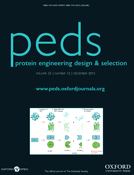
PROTEIN ENGINEERING DESIGN & SELECTION
Scope & Guideline
Bridging Theory and Practice in Biochemical Research
Introduction
Aims and Scopes
- Protein Design and Engineering:
The journal emphasizes novel methodologies for designing proteins, including computational approaches, directed evolution, and rational design. This includes the engineering of enzymes and antibodies to enhance their activity, stability, and specificity. - Computational Methods and Modeling:
A significant focus is placed on computational tools and algorithms that facilitate protein design, such as machine learning, deep learning, and physics-based simulations. These methods are crucial for predicting protein interactions and optimizing structural features. - Functional Characterization and Screening:
Research published in the journal often involves functional assays and screening techniques for evaluating engineered proteins. This includes high-throughput methods for identifying active variants and assessing their properties in biological systems. - Biotechnology and Therapeutic Applications:
The journal covers applications of engineered proteins in biotechnology and medicine, including the development of therapeutics, biosensors, and biocatalysts. This reflects a strong emphasis on translational research that bridges basic science with practical applications. - Sustainable and Green Chemistry:
There is an increasing interest in engineering proteins for sustainable applications, such as biodegradation and bioconversion processes, which contribute to environmental sustainability and resource efficiency.
Trending and Emerging
- Integration of Machine Learning in Protein Engineering:
Recent publications emphasize the use of machine learning and deep learning techniques for protein design and optimization. This trend is significant as it allows for more efficient predictions of protein interactions and functionalities, revolutionizing the design process. - Focus on Multi-specificity and Bispecific Antibodies:
There is a growing interest in the engineering of multi-specific and bispecific antibodies, which are crucial for developing advanced therapeutic strategies. This trend reflects an increased demand for versatile therapeutic agents that can target multiple pathways. - Sustainable Biocatalysis and Green Chemistry:
Research addressing the development of enzymes for sustainable applications, such as biodegradation and biocatalysis in green chemistry, is emerging as a key theme. This aligns with global sustainability goals and the need for environmentally friendly solutions. - Enhanced Functional Characterization Techniques:
Emerging methods for functional characterization, including high-throughput screening and novel assay platforms, are increasingly featured in the journal. This trend is critical for rapidly assessing the performance of engineered proteins in diverse applications. - Applications in Synthetic Biology:
There is an upward trend in research that applies protein engineering principles to synthetic biology, including the design of novel biosynthetic pathways. This reflects an interdisciplinary approach that combines protein engineering with genetic and metabolic engineering.
Declining or Waning
- Traditional Methods of Protein Engineering:
There has been a noticeable decrease in publications focusing solely on classical methods of protein engineering, such as simple mutagenesis and standard biochemical assays. The field has increasingly shifted towards more sophisticated and computationally driven approaches. - General Enzyme Redesign without Specificity:
Publications that broadly discuss enzyme redesign without targeted enhancements for specific applications or functions appear to be waning. This indicates a trend towards more specialized studies aimed at particular industrial or therapeutic goals. - Basic Structural Biology Studies:
Research focused primarily on the structural biology of proteins, without direct implications for engineering or design, has become less frequent. The journal seems to favor studies that integrate structural insights with practical design applications.
Similar Journals

New Biotechnology
Pioneering Tomorrow's Biotechnological BreakthroughsNew Biotechnology, published by Elsevier, is a distinguished academic journal focused on the innovative realms of biotechnology and bioengineering. With an impact factor reflecting its strong presence in the field, this journal serves as a vital resource for researchers and professionals in the life sciences, offering insights into cutting-edge advancements and applications in biotechnology, molecular biology, and related disciplines. The journal's open access policy enhances its accessibility, allowing broad dissemination of knowledge and research findings. With a robust set of Scopus ranks placing it in the top tiers of its categories, including rank #36 in Biotechnology and #24 in Bioengineering, New Biotechnology represents a critical platform for scholars aiming to contribute to the ongoing dialogue in these rapidly evolving fields. Since its inception in 2008 and continuing through to 2024, the journal remains committed to fostering innovation and collaboration among scientists dedicated to advancing biotechnological applications, thereby significantly impacting medicine and industry.
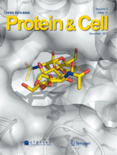
Protein & Cell
Shaping the Future of Scientific Collaboration and DiscussionProtein & Cell, published by Oxford University Press, is a distinguished international journal focusing on cutting-edge research in the fields of biochemistry, biotechnology, cell biology, and drug discovery. This open access journal, active since 2014, is dedicated to disseminating innovative findings that advance our understanding of protein functions and cellular processes, making it an essential resource for researchers, professionals, and students alike. With an impressive 2023 impact factor reflected in its Q1 ranking across multiple categories such as Biochemistry, Drug Discovery, and Cell Biology, 'Protein & Cell' stands at the forefront of scientific research, driving collaboration and discussion in the scientific community. Researchers can access the journal freely online, fostering a global exchange of knowledge and contributing to significant advancements in medicine and biotechnology. Located in the United Kingdom, the journal strives to be a pivotal platform for impactful research that influences future studies and applications.

Journal of Structural Biology-X
Advancing the Frontiers of Molecular ArchitectureThe Journal of Structural Biology-X, published by Elsevier, is a leading open-access journal dedicated to advancing the field of structural biology. Launched in 2019, it has quickly established itself as a vital resource for researchers, professionals, and students, boasting a prestigious Q1 ranking in Structural Biology for 2023 and achieving an impressive Scopus rank of #19 out of 49 in the biochemistry, genetics, and molecular biology category. With an E-ISSN of 2590-1524, this journal emphasizes accessibility and collaboration by providing open access to its comprehensive collection of research articles, reviews, and cutting-edge methodologies. The scope of the journal encompasses significant themes within structural biology, including protein structure, molecular interactions, and imaging techniques, facilitating interdisciplinary dialogue and innovation. Join the global community of scientists and contribute to the body of knowledge that propels our understanding of molecular architecture through the Journal of Structural Biology-X.
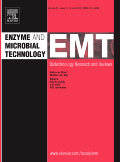
ENZYME AND MICROBIAL TECHNOLOGY
Catalyzing Progress in Bioengineering and BiotechnologyENZYME AND MICROBIAL TECHNOLOGY, a premier journal published by Elsevier Science Inc, serves as a pivotal platform for researchers and professionals dedicated to exploring the dynamic intersections of microbiology, biochemistry, and bioengineering. With a rich publication history dating back to 1979 and converging until 2024, this journal has established itself within the Q2 quartile rankings across multiple categories, including Applied Microbiology and Biotechnology, Biochemistry, Bioengineering, and Biotechnology, highlighting its influential role in advancing scientific discourse. It holds impressive Scopus rankings, where it is recognized in the 79th percentile for Applied Microbiology and Biotechnology and ranks favorably in related fields, making it a valuable resource for academic and industrial researchers looking to stay abreast of the latest developments. Although it does not currently offer Open Access options, ENZYME AND MICROBIAL TECHNOLOGY remains an essential read for anyone invested in the biotechnological applications of enzymes and microorganisms.

Statistical Applications in Genetics and Molecular Biology
Empowering Biological Research with Robust Statistical ToolsStatistical Applications in Genetics and Molecular Biology, published by WALTER DE GRUYTER GMBH, serves as a vital academic platform for researchers and professionals dedicated to the integration of statistical methodologies within the fields of genetics and molecular biology. Established in Germany, this interdisciplinary journal, with an ISSN of 2194-6302 and E-ISSN 1544-6115, seeks to bridge the gap between statistical theory and biological applications, making it an essential reading for those engaged in data analysis, biological research, and computational methods. Despite its current Q4 ranking in key categories such as Computational Mathematics and Genetics, the journal continues to strive for academic rigor and relevance, addressing contemporary challenges and advancements in the field. The journal encourages the submission of high-quality, peer-reviewed research that showcases innovative statistical approaches to genetic and molecular data, providing valuable insights and fostering collaboration among scientists. Exploratory or applied studies that demonstrate effective statistical applications are particularly welcomed, ensuring that both novel and established methodologies are discussed, alongside practical case studies that advance the understanding of biological phenomena. As an open-access journal, it aims to widen the accessibility of cutting-edge research, emphasizing the importance of transparency and sharing knowledge among the scientific community.

CRITICAL REVIEWS IN BIOCHEMISTRY AND MOLECULAR BIOLOGY
Charting New Pathways in Biochemical SciencesWelcome to Critical Reviews in Biochemistry and Molecular Biology, a premier academic journal published by Taylor & Francis Ltd, dedicated to advancing the fields of biochemistry and molecular biology. With an impressive impact factor and a Q1 ranking in both Biochemistry and Molecular Biology for 2023, this journal serves as a vital resource for researchers, professionals, and students eager to engage with cutting-edge reviews and analyses that synthesize the latest developments in these dynamic areas of study. Since its inception in 1972, the journal has maintained a commitment to high-quality scholarship, providing a platform for critical discussions that accelerate the discovery and understanding of biochemical processes and molecular interactions. Although not open access, its robust editorial peer-review process ensures that published articles meet the highest standards of scientific rigor, making it a trusted source for the scientific community. As we continue to converge toward 2024, we invite you to explore the extensive array of topics and findings that have shaped contemporary biochemistry and molecular biology.
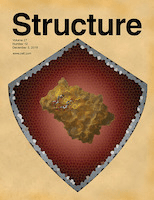
STRUCTURE
Fostering groundbreaking insights into molecular mechanisms.STRUCTURE is a premier academic journal published by CELL PRESS, dedicated to advancing the field of structural biology and molecular biology since its inception in 1993. With an impressive reputation, it is recognized as a Q1 journal in both Molecular Biology and Structural Biology categories, reflecting its high impact within the academic community. The journal holds a significant position in Scopus rankings, placing 10th among 49 in Structural Biology and 100th among 410 in Molecular Biology, marking it as a key resource with a strong influence on ongoing research. Researchers and professionals alike will find STRUCTURE an invaluable platform for disseminating cutting-edge findings related to protein structure, dynamics, and interactions, fostering insights that can lead to groundbreaking applications in medicine and biotechnology. Although the journal follows a traditional subscription model, it continues to attract a diverse array of submissions, ensuring a vibrant exchange of knowledge in the ever-evolving landscape of structural and molecular biology. Access to its content can enhance the understanding of intricate biological mechanisms, making it essential reading for experts, students, and anyone passionate about the molecular underpinnings of life.

Biophysics Reviews
Connecting Researchers to the Heart of Biophysical InnovationBiophysics Reviews, published by AIP Publishing, is an emerging journal in the field of biophysics, aiming to bridge the gap between fundamental biophysical research and applied sciences. With an ISSN of 2688-4089, this journal provides a critical platform for the dissemination of high-quality reviews covering the interplay between biochemistry, molecular biology, biotechnology, and materials science. As of 2023, it provides essential insights for researchers and professionals interested in understanding biomolecular processes at a physical level. Although the journal is not currently open access, it is making strides in establishing its impact in the competitive landscape, as indicated by its Scopus rankings in various related fields, including biochemistry and bioengineering. With a focus on enhancing collaborations among scientists and practitioners, Biophysics Reviews is poised to become a vital resource for anyone looking to deepen their understanding of how biophysical principles can be applied to solve complex biological challenges.

BIOCHIMICA ET BIOPHYSICA ACTA-PROTEINS AND PROTEOMICS
Pioneering Research in Biochemistry and BiophysicsBIOCHIMICA ET BIOPHYSICA ACTA-PROTEINS AND PROTEOMICS, published by Elsevier, is a prestigious academic journal that serves as a vital resource for researchers, professionals, and students in the fields of biochemistry, biophysics, and proteomics. With an ISSN of 1570-9639 and an E-ISSN of 1878-1454, this journal features high-impact research articles aimed at advancing our understanding of protein structure, function, and interactions, contributing significantly to both theoretical and applied sciences. Recognized for its quality, it proudly holds a Q1 ranking in Analytical Chemistry and Biophysics, and Q2 in Biochemistry for 2023, alongside notable Scopus rankings that reflect its influence in the realm of molecular biology. The journal's commitment to disseminating essential findings supports the ongoing evolution of proteomic sciences and encourages collaborative discourse among the global scientific community. For aspiring authors, the journal offers open access options, enabling broad visibility of their work. Join the conversation in this dynamic field and contribute to shaping the future of protein research!
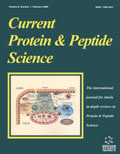
CURRENT PROTEIN & PEPTIDE SCIENCE
Bridging Knowledge Gaps in Protein and Peptide ScienceCURRENT PROTEIN & PEPTIDE SCIENCE, published by Bentham Science Publishers, is a pivotal journal dedicated to the dynamic and rapidly evolving fields of protein and peptide research. With an ISSN of 1389-2037 and an E-ISSN of 1875-5550, this esteemed journal serves as a platform for disseminating cutting-edge findings from various disciplines, including biochemistry, cell biology, and molecular biology. Recognized for its influence with a 2023 Scopus ranking placing it within the top quartiles of its categories—Q3 in Biochemistry, Q4 in Cell Biology, and Q2 in Medicine—the journal not only enhances the visibility of critical research but also supports the academic community in advancing our understanding of the molecular foundations of life. Established in 2000 and running through 2024, CURRENT PROTEIN & PEPTIDE SCIENCE is positioned to cater to the interests of researchers, professionals, and students alike, providing them with open access to vital knowledge that fuels innovation and scientific inquiry in the United Arab Emirates and beyond.